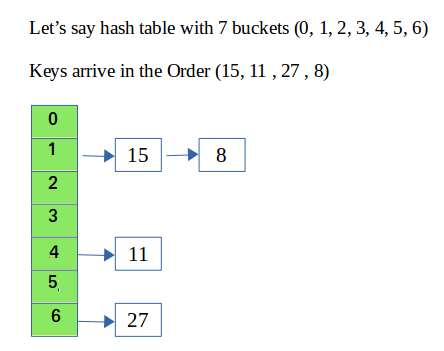In hashing there is a hash function that maps keys to some values. But these hashing function may lead to collision that is two or more keys are mapped to same value. Chain hashing avoids collision. The idea is to make each cell of hash table point to a linked list of records that have same hash function value.
Let’s create a hash function, such that our hash table has ‘N’ number of buckets.
To insert a node into the hash table, we need to find the hash index for the given key. And it could be calculated using the hash function.
Example: hashIndex = key % noOfBuckets
Insert: Move to the bucket corresponds to the above calculated hash index and insert the new node at the end of the list.
Delete: To delete a node from hash table, calculate the hash index for the key, move to the bucket corresponds to the calculated hash index, search the list in the current bucket to find and remove the node with the given key (if found).

We use a list in C++ which is internally implemented as linked list (Faster insertion and deletion).
// CPP program to implement hashing with chaining
#include<iostream>
#include <list>
using namespace std;
class Hash
{
int BUCKET; // No. of buckets
// Pointer to an array containing buckets
list<int> *table;
public:
Hash(int V); // Constructor
// inserts a key into hash table
void insertItem(int x);
// deletes a key from hash table
void deleteItem(int key);
// hash function to map values to key
int hashFunction(int x) {
return (x % BUCKET);
}
void displayHash();
};
Hash::Hash(int b)
{
this->BUCKET = b;
table = new list<int>[BUCKET];
}
void Hash::insertItem(int key)
{
int index = hashFunction(key);
table[index].push_back(key);
}
void Hash::deleteItem(int key)
{
// get the hash index of key
int index = hashFunction(key);
// find the key in (inex)th list
list <int> :: iterator i;
for (i = table[index].begin();
i != table[index].end(); i++) {
if (*i == key)
break;
}
// if key is found in hash table, remove it
if (i != table[index].end())
table[index].erase(i);
}
// function to display hash table
void Hash::displayHash() {
for (int i = 0; i < BUCKET; i++) {
cout << i;
for (auto x : table[i])
cout << " --> " << x;
cout << endl;
}
}
// Driver program
int main()
{
// array that contains keys to be mapped
int a[] = {15, 11, 27, 8, 12};
int n = sizeof(a)/sizeof(a[0]);
// insert the keys into the hash table
Hash h(7); // 7 is count of buckets in
// hash table
for (int i = 0; i < n; i++)
h.insertItem(a[i]);
// delete 12 from hash table
h.deleteItem(12);
// display the Hash table
h.displayHash();
return 0;
}
0 1 --> 15 --> 8 2 3 4 --> 11 5 6 --> 27